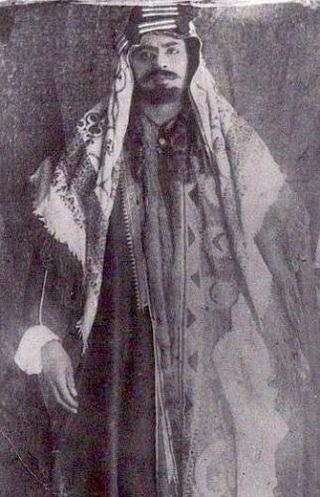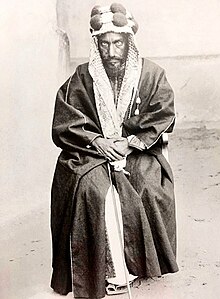
Abdul Rahman bin Faisal Al Saud was the last emir of Nejd, reigning from 1875 to 1876 and from 1889 to 1891. He was the youngest son of Emir Faisal bin Turki bin Abdullah and the father of Abdulaziz, the founder of the Kingdom of Saudi Arabia.

The Rashidi dynasty, also called Al Rashid or the House of Rashid, was a historic Arabian House or dynasty that existed in the Arabian Peninsula between 1836 and 1921. Its members were rulers of the Emirate of Ha'il and the most formidable enemies of the House of Saud, rulers of the Emirate of Nejd. They were centered in Ha'il, a city in northern Najd that derived its wealth from being on the route of the Hajj pilgrimage to Mecca, and was also a commercial center. The rulers of Ha'il were the sons of Abdullah bin Rashid, founder of the dynasty.

The tribe of Shammar is a tribal Arab Qahtanite confederation, descended from the Tayy, which migrated into the northern Arabian Peninsula from Yemen in the second century. It is the largest branch of the Tayy, and one of the largest and most influential Arab tribes. The historical and traditional seat of the tribe's leadership is in the city of Ḥaʼil in what was the Emirate of Jabal Shammar in what is now Saudi Arabia. In its "golden age", around 1850, the Shammar ruled much of central and northern Arabia from Riyadh to the frontiers of Syria and the vast area of Upper Mesopotamia.
Faisal bin Turki Al Saud was the second ruler of the Second Saudi State and seventh head of the House of Saud.

The Emirate of Nejd or Imamate of Nejd, also known as the second Saudi state was existing between 1824 and 1891 in Nejd, the regions of Riyadh and Ha'il of what is now Saudi Arabia. Saudi rule was restored to central and eastern Arabia after the Emirate of Diriyah, the first Saudi state, having previously been brought down by the Ottoman Empire's Egypt Eyalet in the Ottoman–Wahhabi War (1811–1818).

Turki bin Abdullah Al Saud was the founder of the Emirate of Najd, also known as Second Saudi State and ruled Najd from 1823–1834 following administration by the Ottoman Empire.
Saud bin Faisal Al Saud, also known as Imam Saud, (1833—1875) was the ruler of the Second Saudi State in 1871 and 1873–75. He joined alliances with foreign tribes and revolted against his half-brother Abdullah. His rule was short-lived and Abdullah overthrew him. Saud gained power again in 1873 but died two years later. His reign was notable for the infighting in the House of Saud which he initiated.
Abdullah bin Jiluwi Al Saud was one of the early Saudi governors.

Muhammad bin Abdul Rahman Al Saud was an Arabian soldier and politician who played a role in the conquests of his half-brother Abdulaziz that led to the formation of the Kingdom of Saudi Arabia.

The Unification of Saudi Arabia was a military and political campaign in which the various tribes, sheikhdoms, city-states, emirates, and kingdoms of most of the central Arabian Peninsula were conquered by the House of Saud, or Al Saud. Unification started in 1902 and continued until 1932, when the Kingdom of Saudi Arabia was proclaimed under the leadership of Abdulaziz, known in the West as Ibn Saud, creating what is sometimes referred to as the Third Saudi State, to differentiate it from the Emirate of Diriyah, the First Saudi State and the Emirate of Nejd, the Second Saudi State, also House of Saud states.

Abdulaziz bin Mutaib Al Rashid, better known as Ibn Rashid, was the Emir of Jabal Shammar from 1897 to 1906.

The Emirate of Jabal Shammar, also known as the Emirate of Haʾil or the Rashidi Emirate, was a state in the northern part of the Arabian Peninsula, including Najd, existing from the mid-nineteenth century to 1921. Shammar had been a confederation in the Arabian Peninsula. Jabal Shammar in English is translated as the "Mountain of the Shammar". Jabal Shammar's capital was Ha'il. It was led by the monarchy of the Rashidi dynasty. It included parts of modern-day Saudi Arabia, Iraq, and Jordan.

Saud bin Abdulaziz Al Rashid was the tenth Emir of Jabal Shammar between 1908 and 1920.
Abdullah bin Ali Al Rashid was the founder of the Emirate of Jabal Shammar. He founded the Emirate in 1836 and ruled it until 1848. He was called Sheikh due to his noble lineage and military ability.
Abdullah bin Faisal Al Saud was one of the rulers of the Emirate of Najd, also known as Second Saudi State. His reign witnessed extensive struggle among the members of the Al Saud family which led to turmoil in the region.

Muhammad bin Talal Al Rashid was the twelfth and last emir of Jabal Shammar in Ha'il. He ruled from August 1921 to 2 November 1921.
Talal bin Abdullah Al Rashid was the second ruler of the Emirate of Jabal Shammar. He was a skillful ruler who died by suicide. Unlike the founding ruler, Abdullah, who was titled as sheikh, the rulers of Jabal Shammar began to be referred to as emirs with the reign of Talal. In addition, Talal managed to create a state-like administration in the Emirate which had been based on the tribal alliance during the reign of Abdullah.
Bandar bin Talal Al Rashid was one of the rulers of the Emirate of Jabal Shammar. His very brief reign barely lasted a year. He had killed his uncle, Mutaib, to become the emir and was murdered by his other uncle, Muhammad, who ruled the Emirate from 1869 until 1897.
Mutaib bin Abdullah Al Rashid was the third ruler of the Emirate of Jabal Shammar whose reign was very brief between 1868 and 1869.

Prince Abdullah Al-Mutaib Al-Rasheed (1906–1946) was the 11th Emir of the Emirate of Jabal Shammar, from 1920 until 1921.











